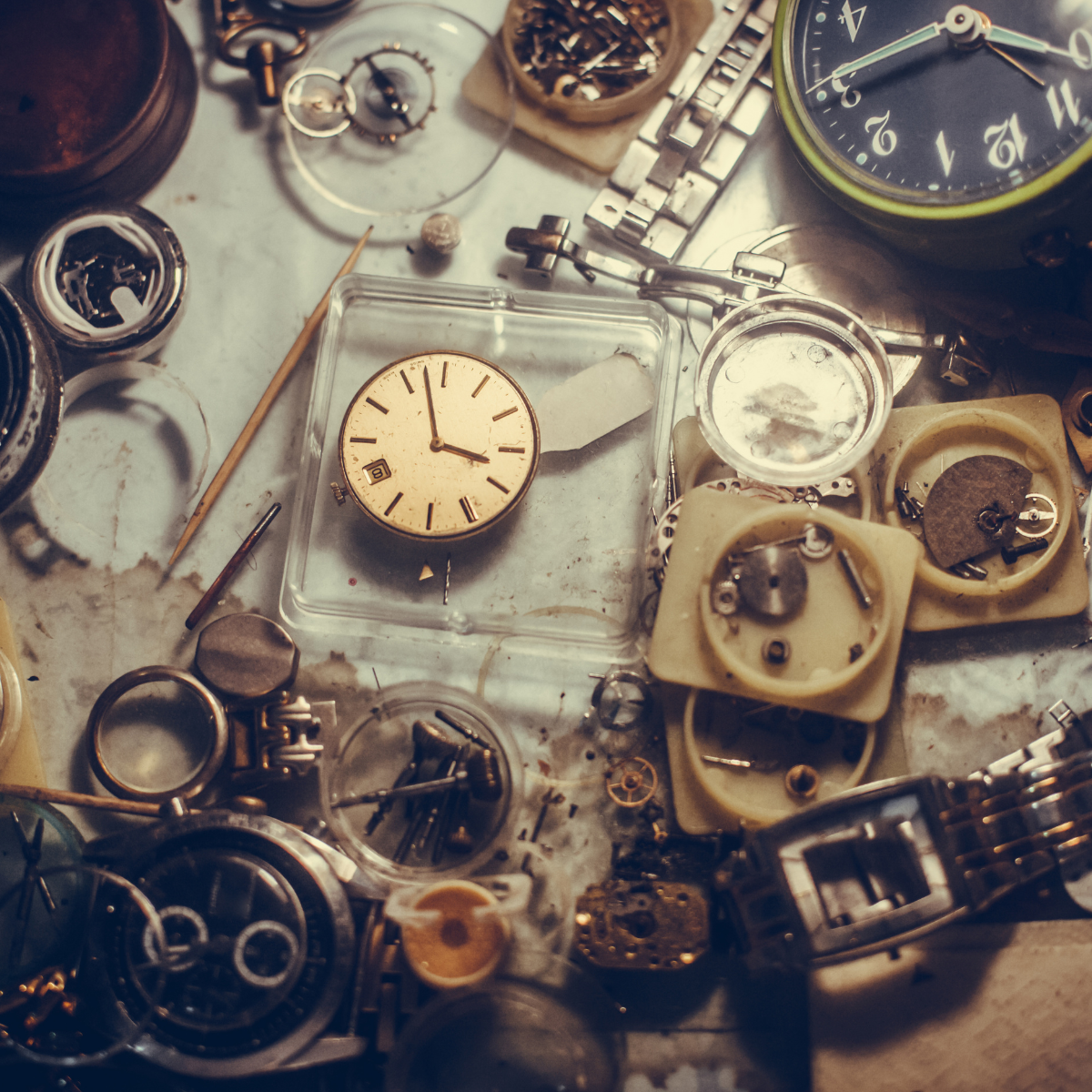
As you put on your wrist, or slip it into your pocket, have you ever wondered how watches actually work? The intricate mechanisms, hidden beneath their elegant exteriors, are far more than just simple timekeepers. In this article, we will unravel the mysteries behind the inner workings of watches, exploring the fascinating combination of technology and craftsmanship that brings these timepieces to life. So, prepare to be amazed as we take a closer look at the intricate world of watchmaking and uncover the secrets of “How Do Watches Work.”

Overview of a Watch
A watch is a timekeeping device that is worn on the wrist or carried in a pocket. It is designed to accurately measure and display the passage of time. Watches have evolved over the centuries, from simple mechanical devices to complex electronic and hybrid timepieces. Understanding the basic components and roles of each component is essential to comprehend how watches work.
Basic Components of a Watch
A watch consists of several essential components that work together to ensure accurate timekeeping. The main components include the case, dial, hands, movement, crown, and strap or bracelet. The case houses and protects the internal components of the watch, while the dial displays the time. The hands, driven by the movement, point to the hours, minutes, and seconds. The crown is used to set the time and wind certain types of watches. The strap or bracelet secures the watch to the wrist.
Role of Each Component
Each component of a watch plays a vital role in its functioning. The movement, also known as the caliber, is the heart of the watch and comprises various parts that work together to measure and display time. The hands indicate the time by rotating around the dial. The case protects the movement from external elements and provides aesthetic appeal. The crown allows for time and date adjustments, as well as manual winding in some watches. The strap or bracelet ensures the watch remains securely in place during wear.
Mechanical Watches
Mechanical watches rely on a series of mechanical components to measure and display time. These watches are powered by a mainspring, and their movements are intricate and fascinating.
The Main Spring
The main spring is a tightly coiled strip of metal that stores potential energy when wound. As the main spring unwinds, it releases this stored energy in a controlled manner, powering the movement of the watch.
Gear Train
The gear train consists of a series of gears that transmit the energy from the mainspring throughout the movement. The gear train controls the rotation of the hands and performs various functions within the watch.
Escapement
The escapement is a critical component of a mechanical watch. It regulates the release of energy from the mainspring, controlling the frequency and accuracy of the timekeeping. The escapement consists of an escape wheel and a pallet fork, which interact to ensure precise movement.
Balancing Wheel
The balancing wheel, also known as the balance wheel, oscillates back and forth, aided by a hairspring. This oscillation sets the pace for the movement of the watch and is regulated by the escapement system. The balance wheel and hairspring combination allows the watch to maintain accuracy.
Jewels in Mechanical Watches
Mechanical watches often incorporate jewels made from synthetic sapphire or ruby. These jewels are used as bearings and pivot points for the gears, reducing friction and wear. The use of jeweled bearings enhances the longevity and performance of mechanical watches.
Quartz Watches
Quartz watches operate using the vibrations of a quartz crystal oscillator. These watches have gained popularity for their accuracy and affordability.
Quartz Crystal Oscillator
The quartz crystal oscillator is a small piece of quartz that vibrates at a precise frequency when an electric current is applied. These vibrations are extremely stable and act as a reference for timekeeping in quartz watches.
Integrated Circuit
The integrated circuit, commonly referred to as the quartz movement, is the brain of a quartz watch. It processes the electric signals from the quartz crystal oscillator, divides them into accurate time intervals, and sends the pulses to the stepping motor.
Stepping Motor
The stepping motor receives electrical pulses from the integrated circuit and converts them into rotational motion. It drives the gears and hands of the watch, accurately indicating the time.
Gear Train and Hands
Similar to mechanical watches, quartz watches also have a gear train responsible for transmitting the motion from the stepping motor to the hands. The hands, driven by the stepping motor, move smoothly and precisely along the dial to indicate the time.
Automatic Watches
Automatic watches, commonly known as self-winding watches, eliminate the need for manual winding. These watches utilize the natural movement of the wearer’s wrist to wind the mainspring.
Rotor and Mainspring
Automatic watches feature a rotor, a weighted component that rotates freely with the movement of the wrist. As the wearer moves, the rotor rotates, winding the mainspring. The mainspring stores this energy for the functioning of the watch.
Role of Gravity
In an automatic watch, the force of gravity helps in winding the mainspring. When the watch is in a vertical position, such as when it is worn on the wrist, the rotor rotates due to the pull of gravity. This continuous movement ensures the mainspring remains wound, keeping the watch powered.
Power Reserve and Winding
Automatic watches have a power reserve, which indicates how long the watch can function without being worn. When the power reserve diminishes, the watch may need manual winding to ensure its accuracy and functionality.

Chronograph Watches
Chronograph watches integrate additional timing functions, allowing the measurement of time intervals and recording of events. These watches are often used in sports and various professional settings.
Start, Stop, and Reset Functions
Chronograph watches typically feature push buttons or pushers that activate the start, stop, and reset functions. The start button initiates the measurement of time, the stop button halts the timing, and the reset button returns the chronograph hands to their initial position.
Independent Sweep Second Hand
Chronograph watches have an additional hand, known as the sweep second hand or chronograph hand. This hand can be started, stopped, and reset independently from the main timekeeping hands, allowing for simultaneous time measurement.
Minute and Hour Counters
Chronograph watches often incorporate additional dials, called subdials, to track elapsed minutes and hours. These counters provide users with the ability to measure and record longer durations accurately.
Kinetic Watches
Kinetic watches combine mechanical and electronic components to create a unique timekeeping experience. These watches utilize the movement of the wearer to generate electrical energy, which is then stored and used to power the watch.
Integrated Circuit and Quartz Oscillator
Kinetic watches, similar to quartz watches, feature an integrated circuit that receives and processes electric signals for accurate timekeeping. The quartz oscillator provides a stable reference for these electrical signals.
Rotor and Rechargeable Battery
In kinetic watches, the movement of the wrist activates a rotor, which generates electrical energy by rotating within a magnetic field. This generated energy is stored in a rechargeable battery, eliminating the need for manual winding or battery replacements.
Power Reserve
Kinetic watches have a power reserve that indicates how long the watch can function without being worn. The stored electrical energy enables the watch to continue operating even when not worn, ensuring accurate timekeeping once worn again.

Digital Watches
Digital watches, as the name suggests, display time using digital numerals or symbols. These watches have evolved from their electronic predecessors and offer a range of features and functionalities.
Digital Display and Light Emitting Diode (LED)
Digital watches utilize a digital display to show the time, often using LED technology. LED displays provide excellent visibility and can showcase various other information, such as date, alarm settings, and additional functions.
Liquid Crystal Display (LCD)
Some digital watches employ LCD displays, which use liquid crystals controlled by electric signals to form the desired numerals or symbols. LCD technology allows for versatile designs and enables the incorporation of additional features.
Power Source
Digital watches are typically powered by batteries, which provide the electrical energy required to operate the electronic components. These batteries need to be periodically replaced to ensure uninterrupted functionality.
Hybrid Watches
Hybrid watches combine mechanical and electronic components, offering the best of both worlds. These watches provide traditional mechanical movements alongside modern smart features.
Mix of Mechanical and Electronic Components
Hybrid watches incorporate mechanical movements for timekeeping accuracy, while electronic components provide additional functionality such as notifications, fitness tracking, and connectivity features. Hybrid watches offer a seamless blend of traditional craftsmanship and modern technology.
Bluetooth Connectivity
One of the key features of hybrid watches is their ability to connect to smartphones and other devices via Bluetooth. This connectivity enables users to receive notifications, control music playback, and track fitness goals conveniently from their wrist.
Smart Features
In addition to basic timekeeping, hybrid watches often include features like activity tracking, sleep monitoring, alarm functions, and even remote camera control. These smart features provide enhanced convenience and utility to the wearer.
Luxury Watches
Luxury watches represent the epitome of craftsmanship, design, and exclusivity. These watches are meticulously constructed using high-quality materials and are often associated with prestigious brands.
High-Quality Materials
Luxury watches are crafted using premium materials such as precious metals, sapphire crystals, and exotic leathers. The use of these materials enhances the durability, aesthetics, and overall value of the timepiece.
Craftsmanship and Design
Luxury watches are meticulously crafted by skilled artisans who pay meticulous attention to detail. From intricate dial designs to polished case finishes, every aspect of a luxury watch is thoughtfully executed, resulting in a visually stunning timepiece.
Exclusivity and Branding
Luxury watches are often produced in limited quantities, making them highly sought after and exclusive. Prestigious watch brands have a long-standing reputation for excellence, and their timepieces are often seen as a symbol of status and luxury.
Maintaining a Watch
Proper maintenance of a watch is essential to ensure its longevity and accurate timekeeping. Regular cleaning, servicing, and battery replacements are necessary to keep a watch in optimal condition.
Routine Cleaning
Regularly cleaning your watch helps remove dirt, dust, and oils that may accumulate over time. Use a soft, lint-free cloth to gently wipe down the case, dial, and bracelet or strap. Avoid using harsh chemicals or abrasive materials that may damage the watch’s surface.
Watch Servicing
Periodic watch servicing by a qualified professional is crucial for maintaining the performance and longevity of your timepiece. Servicing includes disassembling the watch, cleaning the movement, lubricating the necessary parts, and reassembling it to ensure optimal functionality.
Water Resistance
If your watch is water-resistant, it is essential to maintain this feature by regularly checking the seals and gaskets. Over time, these seals may deteriorate, compromising the watch’s water resistance. It is recommended to have the seals replaced during a routine servicing or if any sign of damage is observed.
Replacing the Battery
For watches that use batteries, it is important to have them replaced as needed. A dying or dead battery can affect the accuracy of the watch or even cause damage if left unattended. Consult a professional watch technician for battery replacements to ensure proper installation and preservation of water resistance.
Mechanical Watch Maintenance
Mechanical watches require additional attention to ensure their optimal performance. Regularly winding the watch and keeping it away from strong magnetic fields are crucial. Avoid exposing the watch to extreme temperatures or shocks that may affect its delicate internal mechanisms.
Quartz Watch Maintenance
Quartz watches require minimal maintenance compared to mechanical watches. However, it is important to periodically check the accuracy of the timepiece. If the watch is running significantly fast or slow, a professional adjustment may be necessary.
In conclusion, watches are intricate devices that combine an array of components to measure and display time accurately. Whether it’s the mechanics of a mechanical watch, the precision of a quartz watch, the convenience of a hybrid watch, or the luxury of a high-end timepiece, understanding the intricacies of how watches work allows for a greater appreciation of these fascinating devices. Proper maintenance and care are essential to preserve the functionality and longevity of a watch, ensuring that it remains an accurate and reliable companion for many years to come.

